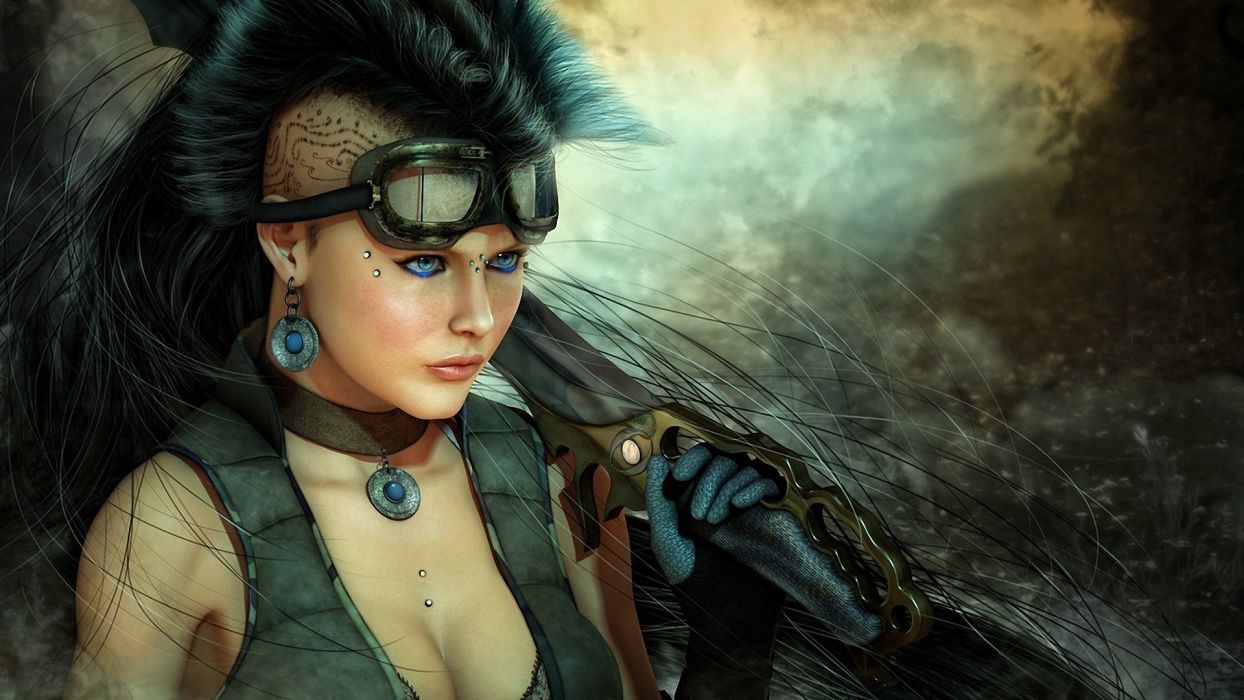
(Image Credit Tianhua Xu)
This is the second instalment of a multi part post if you have not read the first part go here first >
https://steemit.com/life/@tygertyger/the-path-of-the-modern-valkyrie-part-1
So in the first part of this post we went somewhat into the basic foundation of norse pagan philosophy. We also mentioned that within the Asatru there are those who identify as Valkyrie. Obviously they are not mythological creatures who reside in Valhalla but humans who see themselves as human avatars and/or priestesses and followers of ideals and characteristics of said mythological beings. The next 5 instalments will be going into the historical Valkyrie, then we will be moving on to the modern order of the Valkyrie I belonged to, some of their practises and later on we will be getting into things such as runes and rituals. So let's get on with this segment. -
To understand the modern human Valkyrie better we must look into the past of the northern tribes and the significance of the Valkyrie in Norse Mythology. So first let us look into the mythology. First off, while the northern tribes did have the written word through runes their stories traditionally were not written down, for a very long period in history, but passed on by words of mouth. This explains why we can have several versions of a story with slight to substantial variations depending on what country, region or time period that version came from.
So who were the Valkyrie? Traditionally there are two prominent accounts of norse tales and stories about the pantheon and legendary heroes, a cannon so to speak called Sæmundar’s Edda (the poetic Edda) and Snorri's Edda (the prose Edda). Both these collections come to us from Iceland. The poetic Edda being the older one, once attributed to a well known 12century priest called Sæmundar the learned, but now declared by most scholars of being of unclear origin, and the prose Edda the being the younger less stylised one authored by Icelandic scholar and historian Snorri Sturluson. Sturluson’s collection was created in an attempt to make the traditional stories and poems more understandable and palatable to his contemporary peers. While both seem stylised to us modern readers for people of the 13th century it would have been like the difference between spoken english and Shakespearean English. For the longest time the poetic Edda was considered lost until it was rediscovered and sent Denmark as gift to King Christian IV by the Catholic church who renamed the collection the Codex Regius.

(Image credit Howard David Johnson)
So now we know the basics of the Edda (there is a lot more but that is for another time, if you readers are interested) let’s see what these collections and some regional word of mouth stories have to say about the Valkyrie. In the first poem of the Poetic Edda, the Völuspá, a wise woman a “Volva”tell Odin about the creation of the world and makes a prophecy about the end of the gods the Götterdämmerung. In the part she tells the “Allfather” about the Valkyrie and their general and specific functions. The poetic Edda lists six Valkyrie each named for aspects of war,essential trait or weaponry.
They are :
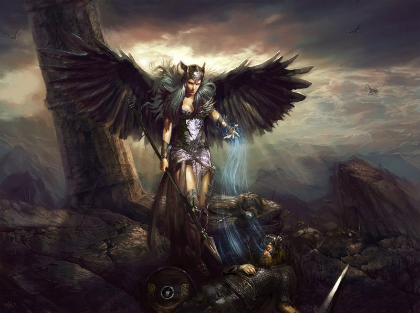
(Image credit Paulo Fernandez)
Skuld- While all Valkyrie go to the battlefield at some point in time Skuld is present at every battle. Skuld ("Shall-be," or "She Who is Becoming”)however is not only a Valkyrie but also one of the 3 sisters the shapers of fate and history, the Norns. She is the youngest of the 3 siblings who sit under the sacred tree of Yggdrasil and spin the fate of all living things. She is also a personification of death as she not only rides on the battlefield to sort out those who will die, collect the dead and bring Odin and Freya the worthy but also as Norn is responsible for the cutting of the cord of fate. While she is the death bringer she is also a bringer of new beginnings as she often unravels and changes the fate her sisters weave. In essence think of this, new beginnings be it spiritual, mental, material or literal reincarnation are always founded on the death or ending of something. Skuld is the personification of that process.

(Image credit Yigit Koroglu)
Skögul- (shaker or the high towering) is an interesting figure as she is in most cases an individual but in one case ( Heimskringla) seen as the same person as her sister Valkyrie Geirskögul. As the one interpretation of her name suggests she is a tall and imposing figure who instills respect. Her main function is to collect the dead and decide on the victory of a battle. She is a supporting force the reliable wing woman.
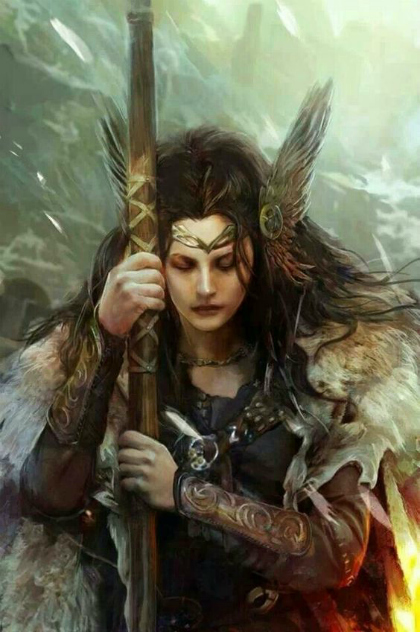
(Image credit Shofa Olivares)
Geirskögul (spear shaker or towering spear) Is seen as either another form of Skögul, her sister or a merged entity. She is the spear bearer and as such points to the chosen on the battlefield with it marking their fate. If Geirsköguls spear is pointing your way it’s game over. In our oder we also saw her as the patron of strategy and planning as well judger of souls. Where Skuld is a wielder and forger of fate Geiskögul asses if you are worthy of your fate.
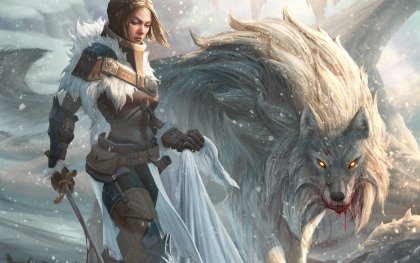
(Image credit Christophe Le Guen )
Gunnr- (Battle) Like Skuld, Gunnr is present at every battle and is the second of the battlefield a-team. The third valkyrie Róta is not mentioned in the poetic Edda but in the prose Edda so she will be discussed in another instalment. She is often depicted as riding a wolf. In my sisterhood we saw her as a patron of wild animals but also as the patron of the wilder nature of humankind. The instinctive.
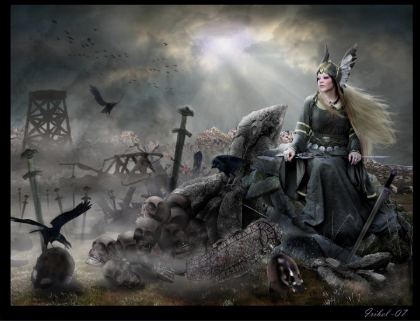
(Image credit Pablo Fernandez)
Hildr- (combat or battle) Is a healer despite her name. She has the power to raise the dead and uses this power to supply troops to the never ending battle between her father Hǫgni and her Husband Hedin (legend of Hedin and Hogni ). Basically her husband had originally kidnapped her when Hogni and he want after her. When he arrived at the Island where Hedin’s troops were waiting Hildr approached him with gifts and an offer of peace from Hedin but in a twist much like the end battle of the English king Arthur with Mordred there was a misunderstanding and a terrible battle ensued. After the battle Hildr resurrected the dead but the dead started fighting again, just to be resurrected by her again in an endless vicious cycle that only ends with the beginning of Ragnarök.
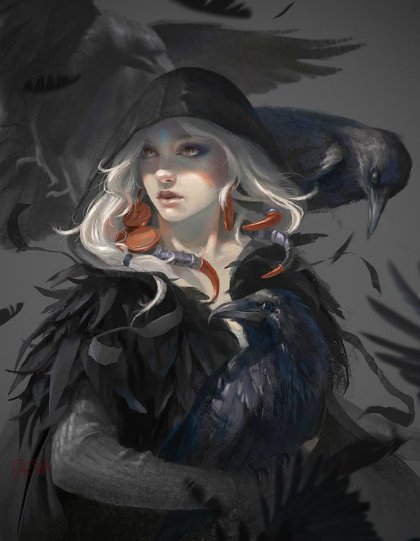
(Image credit Fariba Khamseh)
Göndul- (the wand wielder, wand or magic ) She sets the war between Hogni and Hedin into motion by means of manipulation. First pitting them against each other in playful competition but then escalating the stakes by talking Hedin into abducting Hildr Hogni’s daughter instead of asking for her hand. In some versions of this story Hedin is also told to kill Hogi’s wife which he complies with as well. Obviously Göndul is a darker figure overall and symbolises the unbridled power of magic. While she is not always cruel as in the case of Hedin she unmistakably makes clear that the “feelings” and “wishes” of humans will not deter her from weaving the fate she sees fit for them. Some of her behaviour reminds us a bit of the way Loki approaches things. Many agree that Göndul and Brynhildr are the same person. As Brynhildr she is very much loved by Odin and like Loki she also falls under Odin’s harsh punishment despite his love for her. ( More about that in another segment ).
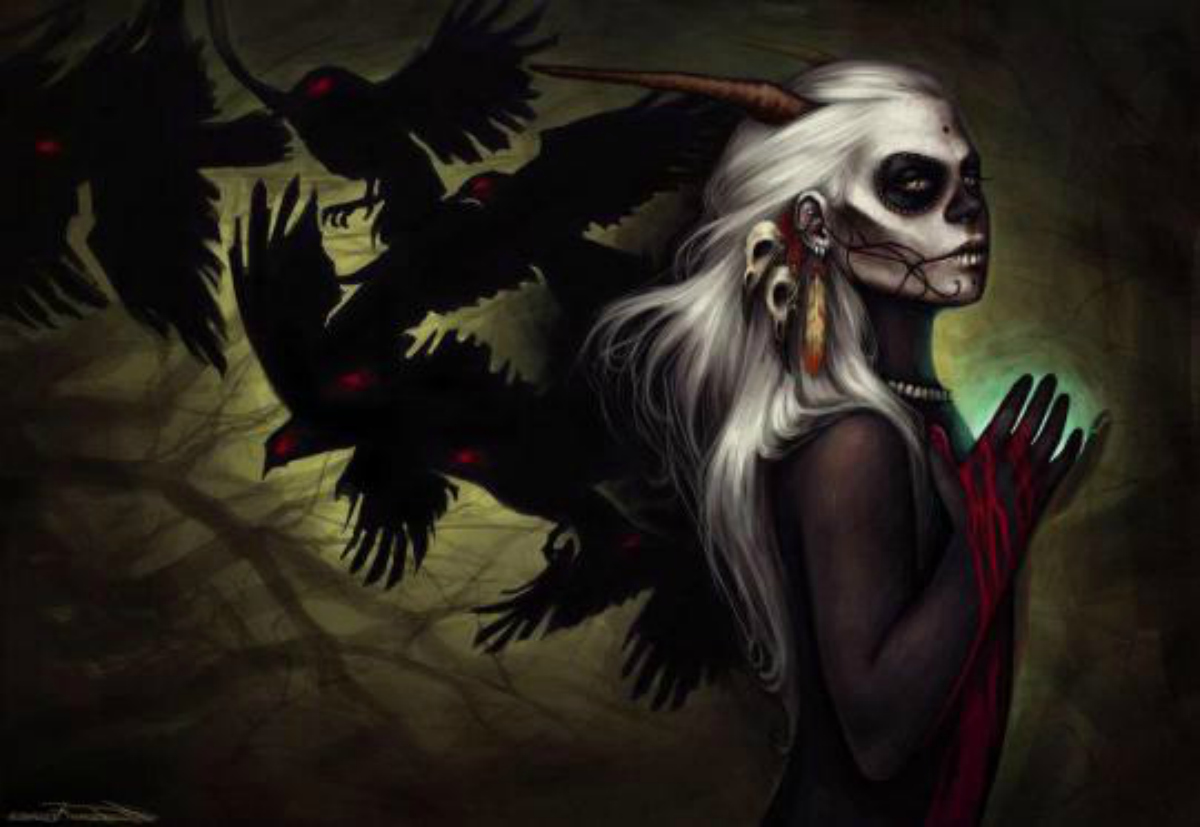
(Image credit Rebecca Joseph )
Some of the Stories around battles are not for the faint hearted in one story about a greater battle the Valkyries are described as sitting at a loom weaving the fates of the warriors out of intestines using swords and arrows as beaters and sculls as weights. They are described to be chanting gleefully while doing so.
Here is a part of that story to give you a feel:
"On Good-Friday that event happened in Caithness that a man whose name was Daurrud went out. He saw folk riding twelve together to a bower, and there they were all lost to his sight.He went to that bower and looked in through a window slit that was in it, and saw that there were women inside, and they had set up a loom.Men's heads were the weights, but men's entrails were the warp and weft, a sword was the shuttle, and the reels were arrows. They sang these songs, and he learnt them by heart:"
"See! warp is stretched
For warriors' fall,
Lo! weft in loom
'Tis wet with blood;
Now fight foreboding,
'Neath friends' swift fingers,
Our grey woof waxeth
With war's alarms,
Our warp bloodred,
Our weft corseblue.
( source Njal's Saga)
This story bears resemblance to the Celtic goddess of war the Morrigan or reminds us a bit of the Indian world cleanser and dark mistress Kali. They are manifestations of part of the nature of human kind turned creature to give us a deeper understanding of ourselves. This concludes the second part of this post until next time stay safe :D
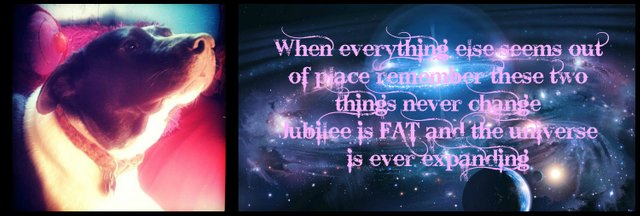
58:00 - 1:00:50 is one of the most beautiful things I have ever seen and heard in my life.
Impressively powerful woman, I bet most girls liked her.
I have Egils saga and the Saga of Grettir the strong in my bookshelf, they will be read soon.
Downvoting a post can decrease pending rewards and make it less visible. Common reasons:
Submit
Thank you for sharing this lovely rendition of Wagner's opera :) and yeah Skuld rocks
Downvoting a post can decrease pending rewards and make it less visible. Common reasons:
Submit
I totally forgot how hard Brunhild's part is to sing this rendition is really good thank you again have been watching it through...
Downvoting a post can decrease pending rewards and make it less visible. Common reasons:
Submit